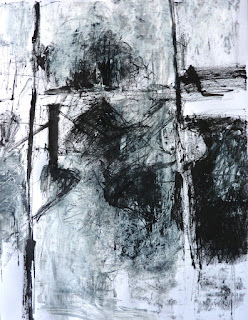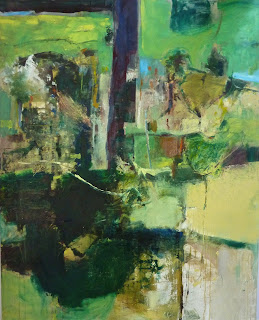oil on paper. 30x30cm
oil on canvas 80x80cm
oil on canvas 120x120cm
Amongst the trees in my garden is a small bush which attracts my attention: it figures in some form or other in all my paintings of late. It is not significant in size or species but it stands there and I am drawn to it.
Wind blows it; light falls upon it; time passes. As an image it can be subsumed in paint or be clearly delineated. I use it as an anchor, an apt metaphor because I am at sea here, lost and trying to gain my footing within a tradition of landscape painting in the British Isles that goes back to the eighteenth century.
The sense of landscape must have been present in some conscious way before that even if it was not formally recognized. Blake and Palmer used it to lament a passing of an age: perhaps a mythic one. Constable and Turner saw in it proof of Godly design and they were not just concentrating on surface appearance, not really precursors of Impressionism.
Landscape as a lived experience, Lanyon or metaphor, Nash and as engagement with the world has continued through Modernism and remains for many a vital, questioning focus of a romantic tradition.
Parmi les arbres de mon jardin, il ya un petit buisson qui m'attire - il est figuré dans une forme ou une autre dans tous mes tableaux récents.
Sa taille ou sa variété n'ont pas d'importance, mais il m'attire.
Il bouge avec le vent, la lumière l'éclaire, le temps passe...Comme image il peut être englobé par la matière ou clairement décrit. Je m'en sers comme d'un ancrage, une métaphore pertinente, car je me sens déboussolé et perdu en train d'essayer de m'orienter dans la tradition du paysage des iles Britanniques du XVIIIe siècle.
Le sens du paysage a dû être présent à l'esprit avant cette époque, même si ce n'était pas formellement reconnu. Blake et Palmer s'en servaient peut-être pour regretter la fin d'une ère, (une qui était peut être mythique). Constable et Turner ont vu dans le paysage la preuve de l'existence de Dieu alors qu'ils ne se concentraient que sur des apparences superficielles - Ils n'étaient pas vraiment des précurseurs de l'impressionisme.
Le paysage, dans l'oeuvre de Peter Lanyon se présente comme une expérience vécue ou chez Paul Nash comme une métaphore.
En tant qu'engagement avec le monde cela a continué à travers le Modernisme et reste pour beaucoup d'artistes d'un grand intérêt et une interrogation concernant la tradition romantique.


















































